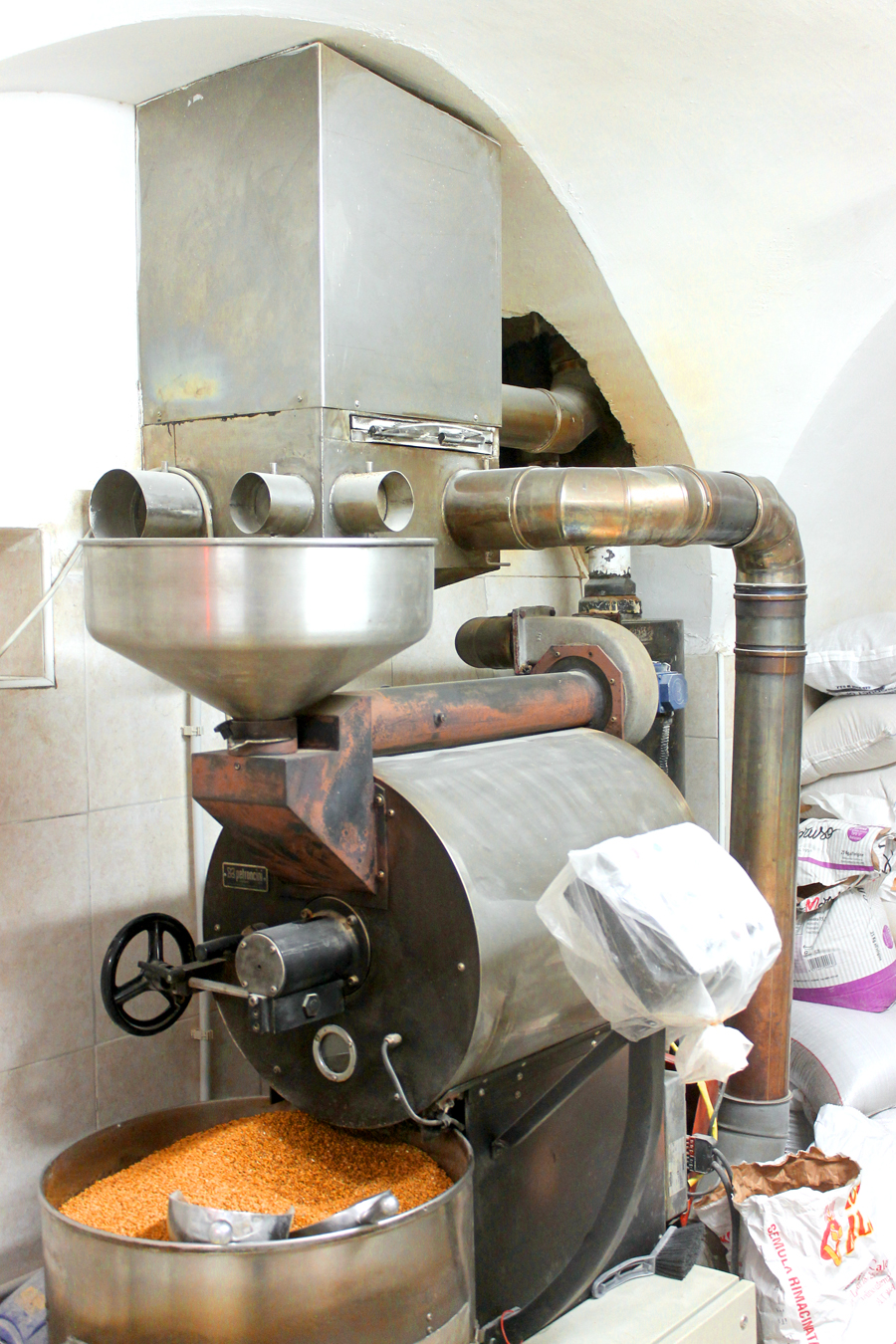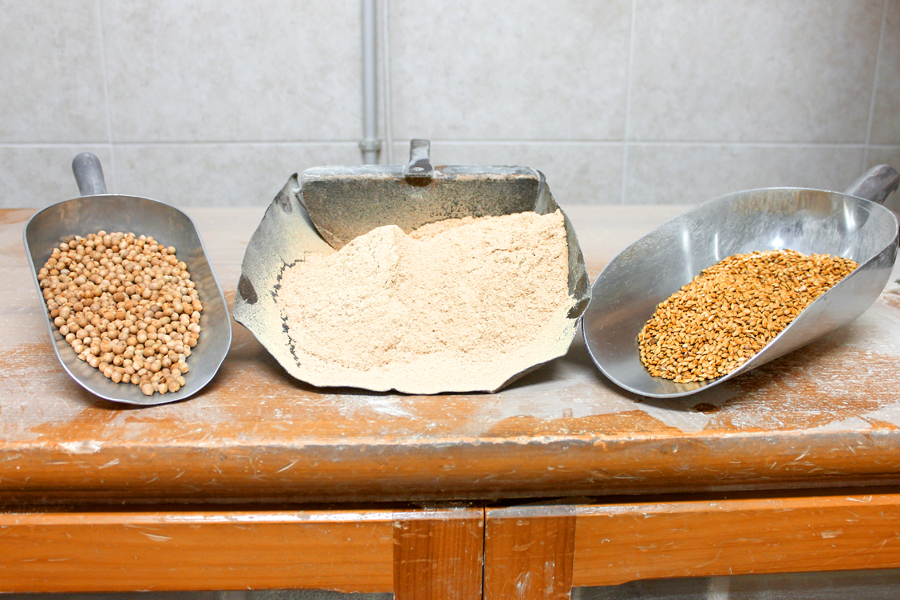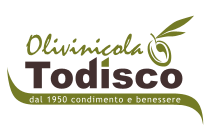 The production of farinella is still entrusted to the hands of local gastronomy artisans, who in small shops with a laboratory behind them, mill every day the quantity necessary for the sale of raw materials, in order to obtain a product that is always fresh.
The production of farinella is still entrusted to the hands of local gastronomy artisans, who in small shops with a laboratory behind them, mill every day the quantity necessary for the sale of raw materials, in order to obtain a product that is always fresh.The transformation phases are essentially two, roasting and milling. It is the right drying temperature and the correct balance in percentage of the ingredients, that is barley, chickpeas and salt, which allow to obtain a balanced product. The raw materials are stored in jute bags to preserve their organoleptic characteristics.
 In principle, one of the two components of Farinella was barley of the so-called "world barley" variety; world probably understood as clean ie sieved cleaned, through "u farnar sc'gghiarul", from weed seeds, for example the seeds "du sciugghij", ie wild grasses such as wild oats and / or forasacchi. In the native language this barley was also called "Jursc gran" (wheat barley). This had a medium grain with the husks (peel) that was eliminated during the threshing phase and therefore the grain remained light to the point that this type of barley was used, soaking it in water for about 12 hours before cooking, for fresh summer soups. .
In principle, one of the two components of Farinella was barley of the so-called "world barley" variety; world probably understood as clean ie sieved cleaned, through "u farnar sc'gghiarul", from weed seeds, for example the seeds "du sciugghij", ie wild grasses such as wild oats and / or forasacchi. In the native language this barley was also called "Jursc gran" (wheat barley). This had a medium grain with the husks (peel) that was eliminated during the threshing phase and therefore the grain remained light to the point that this type of barley was used, soaking it in water for about 12 hours before cooking, for fresh summer soups. .Barley is an ancient cereal present in various parts of the world, the characterization of the one present in the south-east area of Bari and Putignano is given by the clayey soil rich in iron oxides therefore red in color, by the temperature and the angle of the sun's rays during the natural drying phase of the ears which gives them an intense and unique aroma and taste during the roasting and milling phase.
 The other fundamental component of farinella was the rustic chickpea, a type of legume that is very strong and resistant to adversity. It did not fear the cold winters typical of the 372 meters above sea level in the area and, not even afraid of drought, it was never or almost never irrigated. The cultivation cycle started with the sowing in October and ends with the harvest in July. During these phases it did not need much care other than the weeding and tamping of the young plants.
The other fundamental component of farinella was the rustic chickpea, a type of legume that is very strong and resistant to adversity. It did not fear the cold winters typical of the 372 meters above sea level in the area and, not even afraid of drought, it was never or almost never irrigated. The cultivation cycle started with the sowing in October and ends with the harvest in July. During these phases it did not need much care other than the weeding and tamping of the young plants.
The native agricultural tradition in the first half of the twentieth century provided for the biennial alternation of wheat and barley cultivation with that of legumes, including chickpeas. The surface cultivated during the flour year included 70/80% of durum wheat traditionally used, at home, for bakery products (bread, friselle, taralli, etc.), 20% of the Senatore Cappelli variety for pasta. fresh and 5/10% of "world barley" for Farinella. The overall harvest was crammed into sacks and stored in its whole grain form to then be milled from time to time in relation to the weekly / monthly needs of the family.
In the town there were two different mills, one for durum wheat flour and one for farinella.
The history of those years tells that the average consumption per capita of a family of 5 people was 5 kg per year per person with very strong differences between the consumption of those who went directly to work in the fields (peasant men) with those who remained in home (women and young children).
 Flour as the subject of clashes and riots. It was 1902 when, due to the duties on flour which had become heavy and unsustainable for the people, a revolt broke out in Putignano whose purpose was the elimination of exploitation and the abolition of the customs belt. In the early hours of May 14, the betting halls and barracks were burned and subsequently groups of rioters found themselves protesting under the town hall. Consequence of the riot was the death of Margherita Pusteria, a woman present during the riots and several injured.
Flour as the subject of clashes and riots. It was 1902 when, due to the duties on flour which had become heavy and unsustainable for the people, a revolt broke out in Putignano whose purpose was the elimination of exploitation and the abolition of the customs belt. In the early hours of May 14, the betting halls and barracks were burned and subsequently groups of rioters found themselves protesting under the town hall. Consequence of the riot was the death of Margherita Pusteria, a woman present during the riots and several injured.The popular revolt was provoked by the conditions of extreme misery and exploitation in which the poor population, putignanese and not, poured into it in the last decades of the 19th century. It was made up of land workers, mostly peasants, "peasant" fathers, grandfathers and great-grandparents. .
At the trial that followed, the same judges of the Court of Bari, who certainly did not side with the Apulian laborers, wrote verbatim the reasons for the revolt "of squalid desolating poverty and pauperism ... In which today the class of dispossessed of Putignano, because of the "enormous inefficient imbalance between work and wages". to their indignation and anger against the small class of big landowners and rich bourgeois who got fat with the hard work and misery of the land workers. The protest was also directed against the tariff, an inequitable and exorbitant indirect taxation system that weighed especially on poor popular consumption.
Only for food was there a duty on the importation of wheat, the food base of the popular classes, to keep the price of the local product high; there was the duty on food products that came from the countryside to the city for trade or for family self-consumption and also the scarce food that many peasant families were able to produce for their own livelihoods had to pay the duty.
This was also the case, for example, for the fruit of "gleaning", when the women and children of the poorest families, after having asked the owners for permission, gathered, under the scorching sun, the few ears of wheat or barley that it had fallen to the ground and abandoned during the harvest leaving a part of the poor harvest to the landowner at the end of the work. Then, when the wheat was used to go to the mill to transform it into flour, the duty on the land, the hunger tax, had to be paid.
A few months after the aforementioned dramatic events, during the City Council of December 27 with the agenda "Abolition of the consumer duty and abolition of the duty belt", the Marquis Giovanni Romanazzi Carducci, declaring himself in favor of the abolition, had to admit that duty "concerns only the poor". He certainly could not add that this was done in order to avoid imposing a fair taxation on landed property and on the goods and incomes of the wealthy classes, even if he implicitly admitted it "accepting on my behalf any tax that could be imposed only on catkins." abolished towards the end of the year 1902. Except to restore it at the first opportunity, so much so that it remained in force until the years following the second postwar period.
Interesting is the point of view on the life situation in which those concerned, expressed a few years earlier, by an impartial observer, the French father Alessandro Dumas: "While the gentleman feeds his dogs white bread, people live on roots and herbs, with the addition of an inefficient amount of black bread.The lord shelters his horses in well-paved stables and sheltered from the wind and rain.His peasants live in damp and unhealthy hovels, open to all winds , without windows, without roof.The whole family sleeps on a single straw mat, in the same room with the mule, the pig and the chickens.
 What is the Slow Food "Community of Food"?
What is the Slow Food "Community of Food"?The concept of food community is understood as a group of producers and processors who, historically linked to their territory, quality linked to a single work philosophy, ensuring production to the indigenous, respect for planetary and environmental sustainability.
 Slow Food Alberobello, the conduct of the south-east of Bari which encompasses the town of Alberobello, Locorotondo, Putignano and Turi, after a careful analysis of the historical, agri-food and food and wine context, has embarked on the path of enhancing one of the representative elements of the Putignanese context "La Farinella "and in the context of the operational planning for the four-year period 2018-2022, it aims to enhance it, promote it and recover it after having already included it in the Arca dei Gusto (Ark of Taste) of Slow Food, precisely through the concept of the Food Community. The Food Community, called "Comunità della Farinella di Putignano", brings together small local farmers, millers, but also small traders and large producers who act and are committed to act, produce, market, following the Slow Food perspective, truly aware of the human, social, but also and above all economic importance of this approach.
Slow Food Alberobello, the conduct of the south-east of Bari which encompasses the town of Alberobello, Locorotondo, Putignano and Turi, after a careful analysis of the historical, agri-food and food and wine context, has embarked on the path of enhancing one of the representative elements of the Putignanese context "La Farinella "and in the context of the operational planning for the four-year period 2018-2022, it aims to enhance it, promote it and recover it after having already included it in the Arca dei Gusto (Ark of Taste) of Slow Food, precisely through the concept of the Food Community. The Food Community, called "Comunità della Farinella di Putignano", brings together small local farmers, millers, but also small traders and large producers who act and are committed to act, produce, market, following the Slow Food perspective, truly aware of the human, social, but also and above all economic importance of this approach.









 This website project born from the idea of Gianni Musaio is enclosed in a team spirit and is the result of the collaboration of people, ordinary citizens, who care about the historical, cultural, artistic, geographical, food and wine heritage of the historic center of Putignano, a town in to live.
This website project born from the idea of Gianni Musaio is enclosed in a team spirit and is the result of the collaboration of people, ordinary citizens, who care about the historical, cultural, artistic, geographical, food and wine heritage of the historic center of Putignano, a town in to live.








